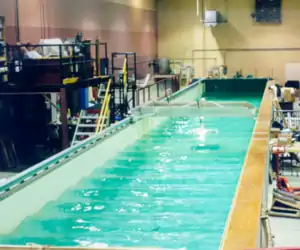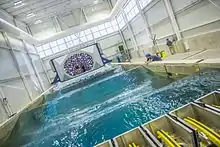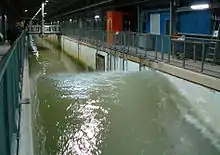Wave tank
A wave tank is a laboratory setup for observing the behavior of surface waves. The typical wave tank is a box filled with liquid, usually water, leaving open or air-filled space on top. At one end of the tank an actuator generates waves; the other end usually has a wave-absorbing surface.[1] A similar device is the ripple tank, which is flat and shallow and used for observing patterns of surface waves from above.

Wave basin

A wave basin is a wave tank which has a width and length of comparable magnitude, often used for testing ships, offshore structures and three-dimensional models of harbors (and their breakwaters).
Wave flume


A wave flume (or wave channel) is a special sort of wave tank: the width of the flume is much less than its length. The generated waves are therefore – more or less – two-dimensional in a vertical plane (2DV), meaning that the orbital flow velocity component in the direction perpendicular to the flume side wall is much smaller than the other two components of the three-dimensional velocity vector. This makes a wave flume a well-suited facility to study near-2DV structures, like cross-sections of a breakwater. Also (3D) constructions providing little blockage to the flow may be tested, e.g. measuring wave forces on vertical cylinders with a diameter much less than the flume width.[3]
Wave flumes may be used to study the effects of water waves on coastal structures, offshore structures, sediment transport and other transport phenomena.
The waves are most often generated with a mechanical wavemaker, although there are also wind–wave flumes with (additional) wave generation by an air flow over the water – with the flume closed above by a roof above the free surface. The wavemaker frequently consists of a translating or rotating rigid wave board. Modern wavemakers are computer controlled, and can generate besides periodic waves also random waves, solitary waves, wave groups or even tsunami-like wave motion. The wavemaker is at one end of the wave flume, and at the other end is the construction being tested, or a wave absorber (a beach or special wave absorbing constructions).[4]
Often, the side walls contain glass windows, or are completely made of glass, allowing for a clear visual observation of the experiment, and the easy deployment of optical instruments (e.g. by Laser Doppler velocimetry or particle image velocimetry).
Circular wave basin
In 2014, the first , circular, combined current and wave test basin, FloWaveTT was commissioned in The University of Edinburgh. This allows for "true" 360° waves to be generated to simulate rough storm conditions as well as scientific controlled waves in the same facility.
See also
Further reading
- Hughes, Steven A. (1993), Physical models and laboratory techniques in coastal engineering, World Scientific, ISBN 978-981-02-1541-5
References
- Wave tank in The University of New Hampshire - Chase Ocean Engineering Lab
- Information on the flume at the Forschungszentrum Küste research institute of the University of Hannover.
- Ocean and Hydraulics Laboratory in KAJIMA Technical research Institute
- Leo Holthuijsen. Waves in Oceanic and Coastal Waters (2018). 404 pag. ISBN 0521129958, ISBN 9780521129954
- Wave Lab at Department of Mathematics, ERAU-DB.
External links
 Media related to Wave flumes at Wikimedia Commons
Media related to Wave flumes at Wikimedia Commons